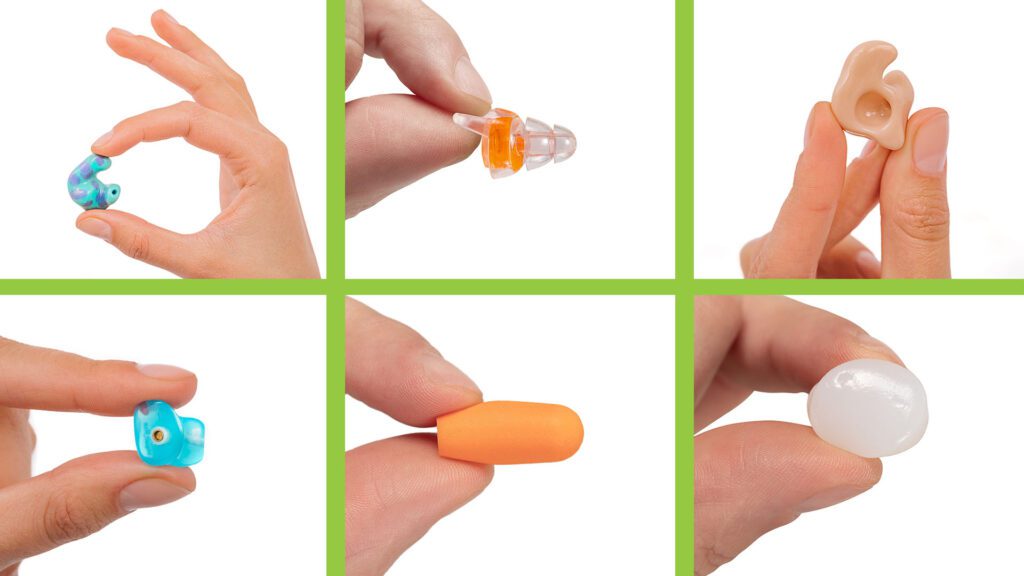
Your Guide to Finding the Best Earplugs (for Sleeping, Concerts, Shooting, Sensory Overload…)
There’s a wide variety of earplugs on the market these days: different sizes, shapes, materials, and designs to suit a range of needs and situations. Some options are downright fashionable, as much accessories as they are functional. The broad selection means you can find earplugs to meet your specific needs, whether that’s hearing protection or simply some peace and quiet.
The options can be overwhelming, so we’ve broken it down and solicited a few audiologists’ advice to simplify your decision. We’ll cover considerations like:
- using earplugs for hearing protection
- what is NRR?
- types of earplugs
- use cases: earplugs for swimming, music, movies, shooting, swimming, and sensory overload
- earplug fit and comfort
Decibels and Hearing Damage: What Decibel Level is Harmful?
Let’s start with the most obvious reason you’d use earplugs: to protect your hearing in noisy environments.
We measure noise in decibels (dB); the higher the decibels, the louder the noise. For example, a still winter day in the woods would probably register 10 – 20 decibels. Compare that to a firetruck siren at 110 – 130 decibels.
dB vs dBA
If you start digging into the science of noise, you’ll come across both dB and dBA. Without geeking out too hard, dB is a measurement of decibels that includes frequencies humans don’t hear. To more accurately gauge the impact on our hearing, dBA is a weighted measurement of noise only in the range that humans can hear. That means the same sound can have a different dB and dBA.
What is Noise-induced Hearing Loss
As a general rule, anything below 70 decibels won’t damage your hearing.
Exposure to noise levels above that, however, can cause temporary or permanent hearing loss. It’s called noise-induced hearing loss, and it can result from exposure to a single loud noise or prolonged exposure to noise that damages the sensitive parts of your inner ear that process and transmit sound waves.
Exposure to loud noise is one of the most common causes of hearing loss. About 19% of the world’s population has some degree of hearing loss, and those numbers are rising. Researchers estimate as much as 24% of American adults and 17% of teenagers have some degree of noise-induced hearing loss.
The higher the decibels, the shorter duration of exposure before you can damage your hearing. The following chart is a guideline for how long it takes for common noise levels to potentially cause hearing loss:
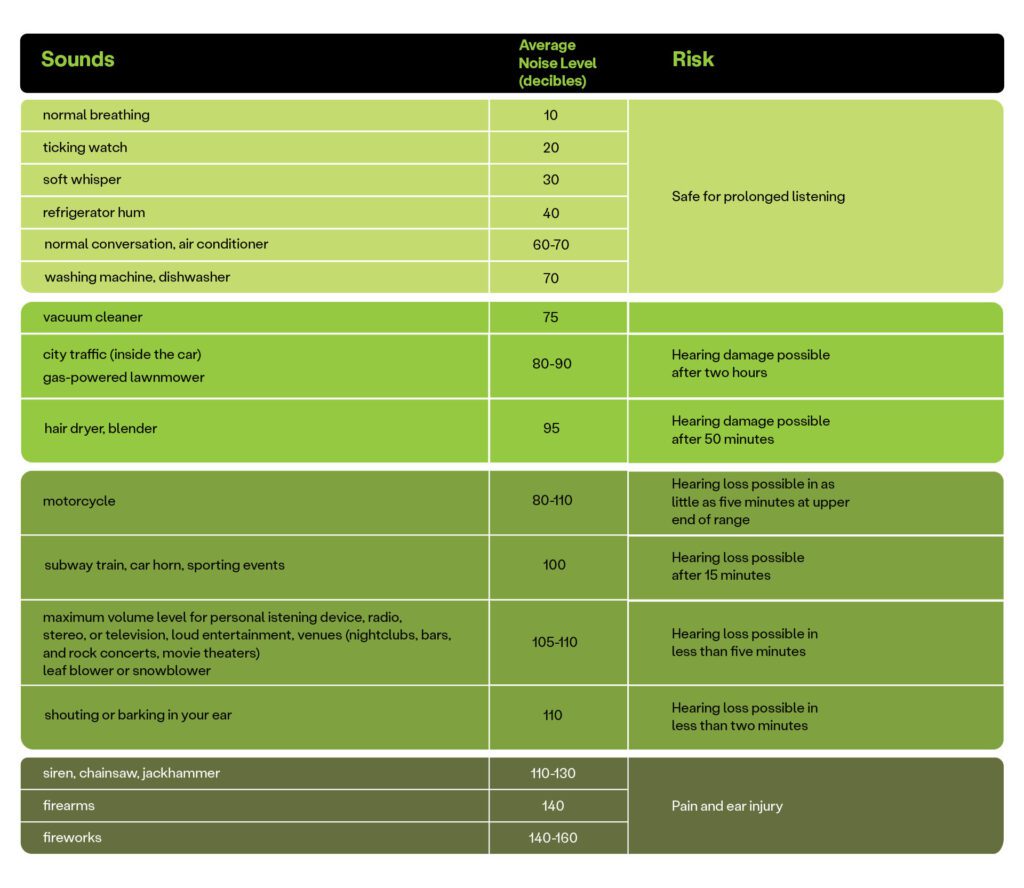
The good news is hearing loss from noise exposure is 100% preventable, and even if you already have some noise-induced hearing loss, you can prevent further damage by using hearing protection, like earplugs.
At What Decibel Level is Hearing Protection Required?
You can gauge from the table above what decibel (dB) level is harmful. To avoid noise-induced hearing loss, you should use hearing protection for prolonged exposure to noise above 70 dB or even a short time in a very loud environment, like near a jackhammer.
Of course, it’s not realistic that you’ll know exactly how loud your surroundings are all the time…though, if you’re interested, you can get decibel meter or sound level meter apps for your smartphone. SoundPrint — which is also on our list of best hearing loss apps — is one example which not only includes a decibel meter, but allows users to submit the noise level of different locations to help others find quiet locations.
Do people with hearing loss need to wear earplugs?
“Volume never seems too loud to me. I have a hard time hearing as it is. Do I still need earplugs?”
Yes. If you have hearing loss, wearing high-fidelity earplugs in noisy places can actually help reduce background noise to allow you to better hear your conversation or music. And wearing any variety of earplug will help prevent further hearing loss.
If you’re concerned about using earplugs for hearing protection because of your existing hearing loss, custom hearing protection from a hearing healthcare provider/audiologist will be especially beneficial, and you may consider captioning as well. Live transcription apps for smartphones are also among our favorite hearing loss apps.
Understanding Noise Reduction Rating (NRR)
An obvious place to start in choosing the right earplugs is with Noise Reduction Rating (NRR). It’s going to be essential to your decision, whether you’re looking for earplugs for sleep, focus, or dangerous noise levels.
What is NRR?
Noise Reduction Rating (NRR) is a standardized measurement of the maximum amount a hearing protection device can reduce the intensity of noise (when used correctly), based on lab tests that factor in type of noise, frequency, and duration of exposure.
Conveniently, you’ll typically see NRR in decibels, so you can gauge whether an earplug will provide adequate noise reduction by subtracting its NRR from the noise level of your intended activity. For example:
- If you’re on a motorcycle, with a noise level around 100 dB, and you’re wearing earplugs with an NRR of 30 dB, your noise exposure works out to 70 dB. That puts your exposure at a safe level even for prolonged riding.
- If you share a bedroom with a loud snorer who’s sawing logs at 60 dB, and you’re using earplugs with an NRR of 20 dB, that reduces your noise exposure to the equivalent of the soft hum of a refrigerator.
When your goal in using earplugs is hearing protection, you should aim for an NRR that will reduce your noise exposure to a safe level, ideally 70 dB or lower.
Maximum Possible NRR
If you’re looking for earplugs with the highest NRR out there, you’re going to top out around 33 dB. For most use cases, that’s enough, but it won’t reduce very loud noise — like gunfire, heavy machinery, or explosions — to safe exposure levels. But you have a couple options to better protect your hearing in very noisy environments.
Dual Hearing Protection
You can achieve an NRR above 33 decibels by combining two types of hearing protection. Most often, wearing foam earplugs and ear muffs together. However, when you double up on hearing protection, you don’t double your NRR. Using a second type of hearing protection will add roughly 5 dB of additional NRR. So if you add ear muffs while wearing earplugs with an NRR of 33 dB, you could get up to 38 decibels of total noise reduction.
Limit Duration of Noise Exposure
If you can’t reduce your noise exposure to safe levels, reduce your length of exposure. When the noise in your environment averages above 70 dB, try to limit the time you spend around it.
For example, if you’re on your laptop and a construction crew is working nearby, making a lot of noise, move to another location where the noise is lower. Another example from Sorenson’s own audiologist Stephen DeMari: avoid positioning yourself right next to speakers at a concert; even with earplugs, that can be unpleasant.
Types of Earplugs
Deciding on a type of earplug can be daunting. There are significant differences in NRR, comfort, and cost. To narrow down the selection, audiologist MarieAnn Z tells us her guidance is simple:
“Consider the situation you will be using the hearing protection, your expectations for hearing in noise (like a concert versus a work environment). Is this something you will use daily, weekly, monthly?”
While you have dozens of options varying in style, material, and cost, they boil down to a few basic categories:

Foam earplugs
Low tech, low cost, and effective. These soft foam cylinders are readily available over-the-counter and have some of the highest noise reduction ratings (NRR) of any earplugs out there. You tightly roll the squishy foam before inserting and let them expand in your ear canal. These don’t play favorites with which sounds they block, so they make it difficult to hear speech (including your own) or music.
NRR: up to 33 decibels
Pros:
- excellent noise reduction ratings
- affordable and widely available over-the-counter
- comfortable for extended use
- available in disposable or reusable options
Cons:
- some users experience discomfort or ear pressure
- may not fit perfectly in all ear canals
- not as “green” an option as long-term reusable varieties
Cost: typically $0.10 – $0.50 per pair for disposable options or $2 – $15 for a reusable pair, depending on the brand and features
NRR: 20 – 33 dB when properly inserted
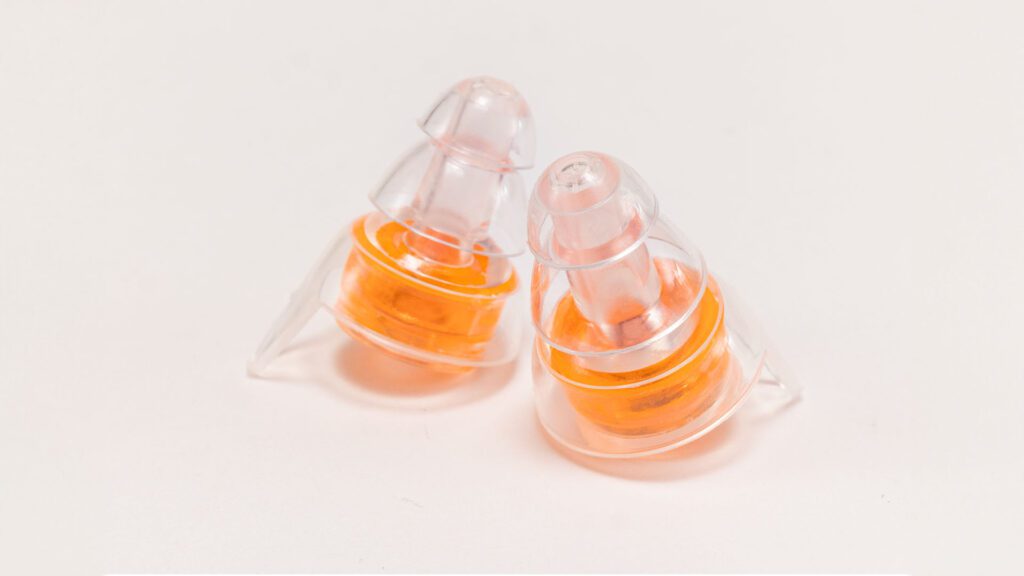
Pre-molded earplugs
These reusable earplugs come in a variety of materials — plastic, rubber, or silicone — as well as several sizes and designs, including fashionable styles. They’re easy to put in, with no rolling required, and may create less sensation of pressure in your ear than expanding foam.
This category can include high-fidelity (hi-fi) earplugs, also called uniform-attenuation earplugs. They have the same effect as turning down the volume on a stereo: the sound intensity decreases evenly across different pitches, so it’s not distorted. You might find high-fidelity earplugs especially helpful at movies or concerts so you can appreciate audio quality and speech.
Pros:
- selection of sizes to better fit your ear canal
- reusable and easy to clean
- some create a watertight seal, making them suitable for swimming
- high-fidelity options
- range of aesthetic options, including color and shape
Cons:
- may be more expensive than other non-custom earplugs
- less noise reduction for extremely noisy environments
- some users find them less comfortable for extended wear
- it’s possible for varieties with silicone tips to come loose and get stuck in your ear
Cost: may range from as low as $10 for basic options to as much as $50 for specialized and high-fidelity
NRR: 15 – 25 dB

Canal caps
Canal caps come in both pre-molded and formable varieties. You can even get custom-made canal caps as well as over-the-counter. Their distinguishing features is a stiff band that applies light pressure to hold the earplugs in place while inserted, and when not in use can hang around your neck. That makes them a popular choice among users who alternate between needing hearing protection in noisy environments and needing to hear clearly.
Because canal caps can include both off-the-shelf or custom options as well as formable or molded earplugs, cost and NRR will vary.
Pros:
- a snug and secure fit
- multiple options for different use cases
- custom and off-the-shelf varieties available
Cons:
- may be more expensive than basic foam earplugs
- limited size and shape options mean some users find them less comfortable for extended wear
Cost: a wide cost range, depending on features, intended use, and whether you opt for custom canal caps. Off-the-shelf, you may find a pair for as little as $5, while custom options may cost up $100 – $500.
NRR: varies by fit and material
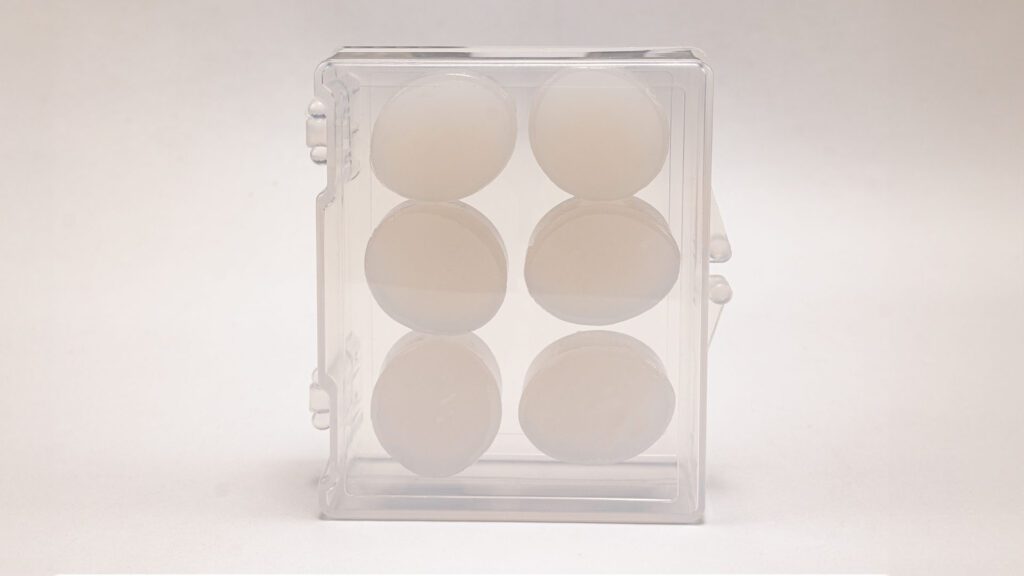
Wax or silicone putty earplugs
Wax or silicone putty earplugs are the most pliable variety of hearing protection, allowing you to shape them to your ears for a comfortable fit and a tight seal. However, wax or silicone isn’t the best material to insert into your ear canal, which limits the effectiveness of this type of earplug for noise reduction. Audiologist Stephen DeMari points out they’re still a better option than no hearing protection at all or shoving cotton or tissue in your ears.
Pros:
- mold to the shape of your ear, so you can adjust fit
- can create a watertight seal for swimming and water-related activities
- soft for comfortable use while sleeping
Cons:
- less effective in very noisy environments
- some risk of melting in ear canal
Cost: typically $2 – $10
NRR: 20-25 dB
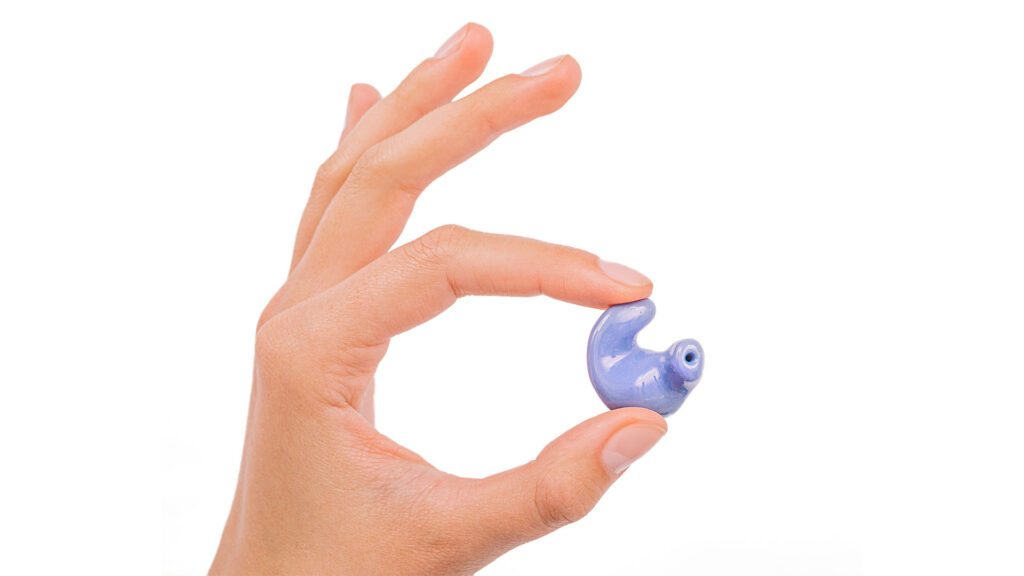
Custom molded earplugs
Custom earplugs from a hearing health professional are the top-tier option for hearing protection and comfort. The provider will take a mold of your ears to create a perfect fit for your ears specifically. You can also tailor the design, NRR, and noise filtering for your intended usage — for everything from sleep to construction work. Custom fit earplugs also typically allow you to choose their color, even including options like glitter, glow-in-the-dark, or marbling effects.
Pros:
- ideal fit for maximum comfort
- fully customizable to your intended use and NRR needs
- high-fidelity options
- lower risk of getting stuck in ears
Cons:
- more expensive than most off-the-shelf options
Cost: $100 – $300+
NRR: 15 – 33 dB
If you consult a hearing health professional for custom hearing protection, you may also want to take the opportunity to test your hearing. If you already have some degree of hearing loss, an audiologist can recommend a holistic plan to protect you from further hearing loss and improve your day-to-day hearing as well.
If you have hearing loss that’s affecting your ability to use the phone and you need captions for your calls, your hearing health provider may suggest you sign up for no-cost phone call captioning using the CaptionCall Mobile app by Sorenson or CaptionCall by Sorenson for home phone.
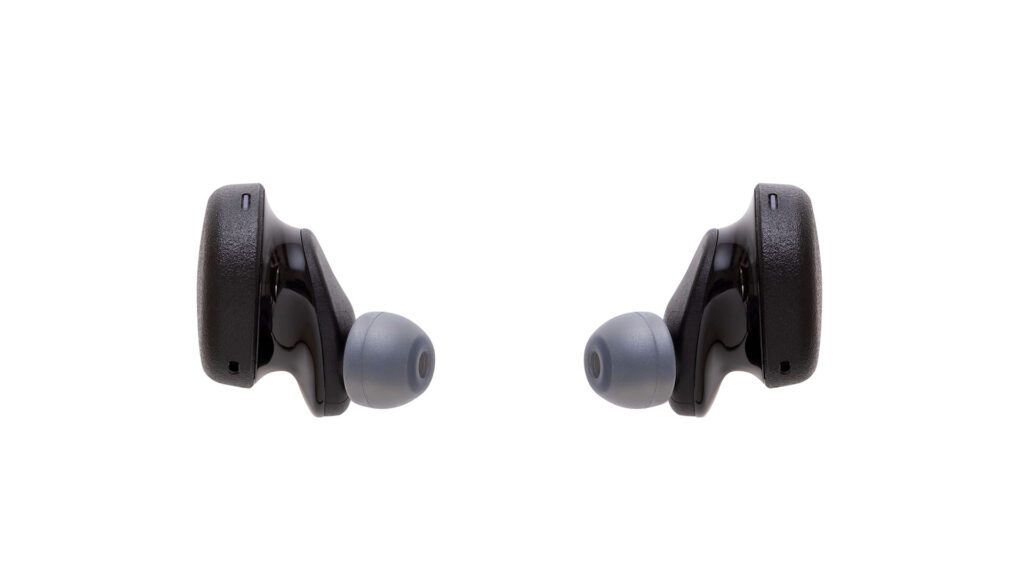
Noise cancelling earplugs
In addition to conventional earplugs that physically block noise (noise reducing earplugs), you also have the option to tap into digital technology in the form of noise cancelling earbuds. These electronically cancel out specific frequencies, like the hum of an airplane engine or the hubbub of a busy location. Because they can connect to your devices, noise cancelling earplugs will also allow you to listen to audio through them while they remove background noise around you — earplug headphones.
Pros:
- counteracts bothersome frequencies
- double as earphones for listening to audio
Cons:
- cost is higher than many other off-the-shelf earplugs and may be more expensive even than custom earplugs
- don’t protect hearing from sudden loud noises
- require batteries or charging
- limited size and shape options mean some users find them less comfortable for extended wear
Cost: can range from $50 to $300+, depending on brand and features
Choosing the Right Earplugs for Specific Use Cases
Earplugs for Sleeping
Comfort is critical when choosing earplugs for sleeping, and comfort will come down to a combination of material and fit. You’re likely to have the best luck with a soft material: foam, silicone, or wax.
Audiologist Marnie R. recommends that if you’re using earplugs primary for sleeping, size and shape are also worth considering:
“Sleeping plugs are most comfortable if they are made CIC style, just in the canal. The material should be somewhat softer than a standard earplug, so as not to cause discomfort if you are a side sleeper.”
To decide on an NRR, consider whether you want near-silence or need to be able to hear some sounds. For example, if you want to be able to hear a crying baby or are worried you won’t wake up to your alarm, you might choose an NRR in the mid to upper teens versus an NRR of 25 or above if you’re a light sleeper trying to drown out city noise or you share a room with someone who snores.
You can also try noise canceling earplugs for sleeping, but the firmer material may not be comfortable for side sleepers.
Earplugs for Concerts, Musicians, and Movie Theaters
High-fidelity (hi-fi), or uniform attenuation, earplugs are going to be your best bet when you want to clearly hear audio while lowering the noise level. Pre-molded or custom fit earplugs offer this option, using filters to preserve sound quality and still lowering your noise exposure to prevent hearing damage.
For musicians or people who frequently attend concerts or movies, custom earplugs may be worth the investment for a perfect fit plus the ability to tailor them to your specifications for sound filtering.
As far as the NRR of earplugs for concerts, the decibel level of indoor live music can easily be more than 100 decibels, so you won’t regret an NRR of 25 of higher.
Earplugs for Shooting
When you’re looking for earplugs for the shooting range, go for maximum NRR. Either foam earplugs or custom earplugs with an NRR of 30+ are a must, and earmuffs on top of them is a good idea.
For hunting, it’s still important to protect your ears from the damaging decibel levels of gunfire, but it’s understandable you do want to be able to hear other sounds around you. Some companies make specialized electronic earplugs that can activate noise suppression when they detect loud noise, but amplify ambient sound when it’s quiet so you can hear what you need to.
Earplugs for Focus, Sensory Overload, and Audio Sensitivity (Hyperacusis and Misophonia)
Individuals with sensory sensitivities, hyperacusis, or misophonia — including some people with autism or ADHD — notice significant benefit from using earplugs to reduce sensory overload or improve focus by blocking distracting noise.
What is Hyperacusis? What is Misophonia? And What’s the Difference?
Hyperacusis is a heightened sensitivity to even everyday sounds that makes them seem louder to you than to everyone else, even to the point of hurting your ears.
Misophonia is an extreme dislike of certain noises, even at a normal volume, to the point that hearing them makes you agitated or downright angry. For example, hearing other people chew.
If you deal with hyperacusis or misophonia earplugs can stifle offending noises and offer a little peace.
Because you’re likely to wear these regularly and potentially for extended periods, comfort is likely to be a priority. Your most comfortable option is custom earplugs.
For a less expensive choice, foam, wax, or silicone putty earplugs are soft and bendable to the shape of your ear. These will block or muffle all noise, which may be exactly what you want.
You may prefer to block distracting or overstimulating ambient noise while still being able to clearly hear music or someone speaking to you, making high-fidelity custom or pre-molded varieties your best choice.
If your intended use is noise sensitivity and not hearing protection, noise cancelling earplugs may also work well for you.
Earplugs for Swimming
Swimming earplugs have one job: create a watertight seal to keep water out of your ears. But that doesn’t mean you can’t put them to work on two fronts. The best earplugs for swimming can also offer hearing protection to extend their usefulness.
Custom earplugs, wax, or well-fitting pre-molded earplugs can all seal off your ear canal from water. The custom or pre-molded route are reusable and can also offer hearing protection, so they’re an investment you’ll get double use of.
Just a one-off need because you forgot your molded earplugs? Wax or silicone putty are affordable and can do the job. Avoid foam earplugs for swimming because they’ll act like a sponge in the water.
Earplug Fit and Comfort
Remember that the effectiveness of earplugs also depends on proper fit and usage. No matter how much you spend on a set of earplugs or how high the NRR, they’re not going to give you the results you want if the fit isn’t right or you don’t have them inserted correctly.
Audiologist Marnie R. says nothing is more important than getting the right fit on your earplugs for comfort and effectiveness:
“I work with an office that does almost as much hearing protection as we do hearing aids. What we have found is that for those wanting hearing protection for hunting/concerts/construction...etc, the fit is extremely important…Custom built hearing protection works so much better than foam earplugs.”
Without investing in custom hearing protection, you can opt for foam earplugs or wax/silicone putty for their ability to form to the shape of your ear. The softness of the material means nearly anyone can squish the material to fit their ears.
With any earplugs, proper insertion will make or break their noise reduction and comfort. With foam plugs in particular, it’s important to follow the instructions, twisting them down to the narrow width you can fit in your ear canal and then letting them expand in your ear. Earplugs that comfortably fit deep in your ear canal will provide the most sound reduction.
DeMari suggests looking in a mirror or asking someone to look at you straight on. If your earplugs are visibly sticking out, they’re not in correctly.
Even in the case of fashionable pre-molded earplugs designed to be visible, they shouldn’t be hanging out of your ears. If you can’t wear them securely without discomfort, they’re not a good fit. Because no two people’s ears are quite the same size and shape, a molded earplug that comfortably fits someone else won’t necessarily fit you.
Material makes a difference not only in fit and use case, but also if you have allergies to plastics, silicone, or latex. If you have allergies to these common earplugs materials, you can ask a doctor or audiologist about alternative options.
Where to Get Earplugs
Ultimately, the best choice of where to buy earplugs is going to come down to how you plan to use them.
From a hearing health provider
All of the audiologists we talked to agree that custom molded earplugs from a hearing health professional will give you the best fit for comfort and effective noise reduction. So for regular use — or if you struggle with earplugs that don’t fit your ears — they may be worth the investment.
To find a hearing health care provider, you can search through your health insurance directory, especially if you want to establish a relationship for hearing health care.
You can also look for providers in your area using an online directory like the one through Healthy Hearing to browse thousands of hearing health clinics.
Off-the-shelf
However, off-the-shelf options are perfectly acceptable for one-time or occasional use. You can find foam earplugs at a wide variety of retailers: hardware stores, pharmacies, department store chains, even some convenience stores carry them.
There’s a large selection of pre-molded earplugs and noise canceling earplugs online, but you can also find options from big box retail stores and specialty music stores.

